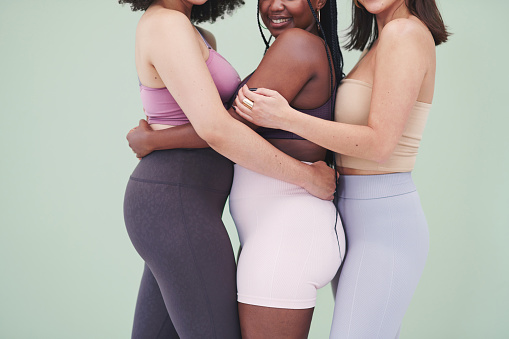What Happened to the Body Positivity Movement?
How social media has muddled the true meaning behind the body positivity movement

I am woman!
April 5, 2022
Body positivity was once a powerful social movement, but it has digressed into a misconceived social media trend. I came to this revelation during the pandemic when my weekly time on screen was at its peak. With so much free time, my digital world took over my life. I began relying heavily on social media as my source of serotonin, and it transformed into a fixation on the imperfections of my life. I found myself scrolling through Instagram, being bombarded daily by flawless influencers and their unrealistic bodies. Looking at these pictures of white, cis-women just slightly larger than the thin ideal posing in a bikini with their backs hunched over to create miniature fat rolls, with the caption #body-positivity, quickly heightened my pre-existing unrealistic beauty standards.
To continuously see models who fit the beauty standards try and associate with the word body positivity felt contradicting. According to Cambridge Dictionary, “Body positivity is rooted in loving your body and gaining self-confidence”. While these platforms are most certainly promoting personal confidence, the lack of diversity in social media creates a meaningless approach to a movement all about accepting and appreciating different bodies. Moreover, body positivity was created by and for marginalized bodies in the 1960s. In particular, the movement focused on representing people of all sizes, shapes, colors, abilities, sexual orientations, gender identities, and those that fall within those intersectionalities. Therefore, the word should reflect diversity and acceptance of people who don’t fit the beauty standard.
With the explosion of social media, the body positivity movement gained a lot of traction online and subsequently became adopted by those for whom the movement wasn’t curated. Although the body-positivity movement should adhere to everyone, the front of the movement has been taken over by influencers who picked up on the popularity of the hashtag and made it a performative trend.
Taking advantage of the phrase, body positivity, on social media has been an issue for over a decade now. The most prevalent issue is the recently famed Tik Tok star, Sienna Mae Gomez. At the age of 16, Gomez cultivated millions of followers after posting body confidence and dancing videos on Tik Tok in 2020. Now two years later, she has gained over 21 million followers and became titled the face of online body positivity. Her content on Tik Tok consists of videos showing off her eating, dancing, and being confident. Most of these videos portray her pushing out her stomach to create a protruding belly when eating or dancing. While she is most notable for preaching to her followers about self-love, she would not be where she is today without the exploitation of the word body positivity.
Through her lack of representation, it’s clear that these Tik Tok videos’ primary focus is to grow her following as her vulnerability online is what originally brought her fame. Without it, she would no longer be considered the face of body positivity. Although I do believe it’s important to be confident about your body, it’s easy to be confident when the social standards apply to you. Gomez fits the subjective beauty standards with her toned mid-size hourglass figure. This is not to say that you can’t feel bad about your body if you fit the beauty standards. Gomez has talked about her issues around eating and how it’s impacted her body image negatively on her Tik Tok but what separates her from the movement is she will never experience body discrimination. For example, if a plus-sized woman who did not have Gomez’s hourglass figure was seen creating similar content, she would most likely be harassed for her weight and called out for “promoting” obesity. This is apparent for even popular celebrities like Lizzo, who promotes the same values as Gomez but is treated poorly because she is an actual plus-sized woman.
While some may argue that the body positivity movement should include all body types, its current misrepresentation takes advantage of its original definition. The word has slowly lost its foundational value as it is constantly overused and abused in social media. Now more than ever, it feels like the word has lost its association with the body liberation movement and has transgressed into a new connotation. As a society, we must begin introducing all types of bodies in media while providing better representation for marginalized ones. We must move away from body positivity and strive for body neutrality to begin that push. BYRIDE explains, “At its core, body-neutrality is the idea that you can exist without having to think too much about your body one way or another, positive or negative. You can simply exist and be worthy of respect without thinking about your body at all”. Instead of depending on the physical attractiveness of our bodies to define our worth, we as a society must celebrate our bodies’ remarkable abilities and differences in order to push back beauty standards.

